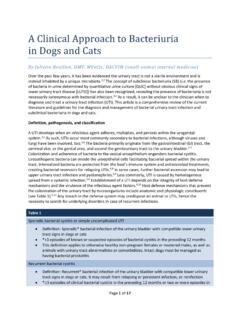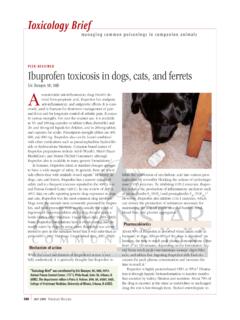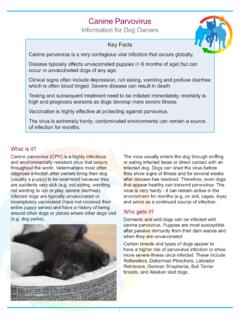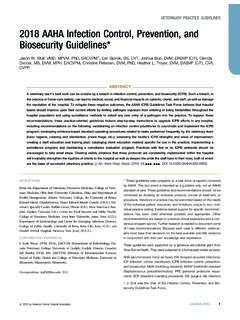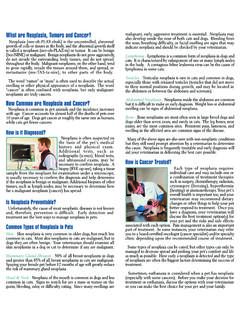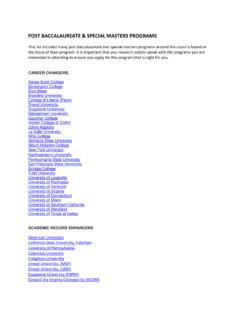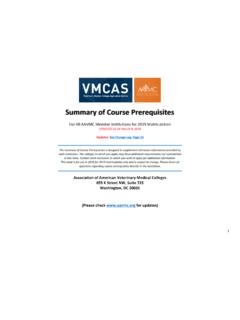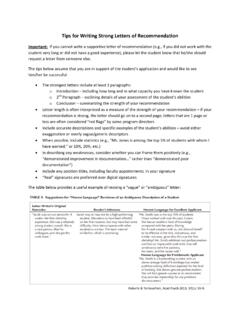Transcription of The Veterinary Practice Team - VetMedTeam
1 1 The Veterinary Practice Team Delegation of Tasks What makes a Veterinary Practice a success? The Vet erinary TEAM is the answer. This team is made up of individuals with different training, credentialing, backgrounds, personalities, qualities, and skills that all contri bute to the success of the Practice . Each member is a crucial part of the team and brings their special talent to the team. One team member may be great with the clients and handle the reception area beautifully but doesn t have the patience to dr aw blood or restrain the angry cat in the treatment room. Another team member may have the patience to handle the cat but not the client or the reception area. A truly great Veterinary team is made up of these diff erent individuals who develop a respect for one another.
2 The Veterinary team involves all members of the staff. Roles and duties vary by Practice and credentialing and are typically defined in an employee manual. The staff that works together as a TEAM usually pr ovides better patient care, client care, and employees lik e coming to work more than those employees that work as individuals. When a team environment is created, all roles involved in the Veterinary health team are rewarded. Veterinary Healthcare Team members can include the following: Students Groomers Kennel Assistants Veterinary Assistants Veterinary Technicians Veterinary Technologists Veterinary Technician Specialist Receptionists Practice Managers Office Managers Veterinarians 2 Veterinary Technicia n (LVT, CVT, RVT) In recent years, the profession of Veterinary medicine has become ever more sophisticated and complex.
3 The public expects state-of-the-art Veterinary care for animals. To provide high quality service, today's Veterinary team ut iliz es the skills of trained professionals known as Veterinary technicians. As per the American Veterinary Medical Association, Veterinary technicians perform valuable medical and non-medical services in clinical Practice . The Veterinary technician is educated and trained to support the veterinarian by assisting with surgery, laboratory procedures, radiography, anesthesiology, prescribed treatment and nursing, and client education. A Veterinary technicia n is a graduate of an AVMA accredited program in Veterinary technology, usually leading to an Associate or Bachelor degree. In additi on, almost every state requires a Veterinary technician to pass a credentialing exam to ensure a hi gh level of competency.
4 States may have different credentialing designations; RVT, CVT, LVT. Some Veterinary technicians pursue specialties in areas such as emergency and critical care, anesthes iology, internal medicine , animal behavior, or dentistry. Personal attributes that contri bute to a successful career as a Veterinary technician in clinical Practice include a st rong science background, an ability to work well with people and animals, and good communication and decision-maki ng skills. Duties and responsibilit ies The Veterinary technician is an integral member of the Veterinary health care team. Veterinary technicians have been educated in the care and handling of animals, the basic principles of normal and abnormal life processes, and in many laboratory and clinical procedures.
5 All Veterinary technicians work under the supervision of a licensed veterinarian. While a Veterinary technician can assist in performing a wide variety of tasks, they cannot diagnose, prescribe, perform surgery, or engage in any activity prohibited by a state's Veterinary Practice act. In private Practice A Veterinary technician employed in a Veterinary clinic or hospital handles many of the sa me responsibilities that nurses and other professionals perform for physicians. Some of the tasks they are training to do include: Obtain and record patient case histories Collect specimens and perform laboratory procedures Provide specialized nursing care Prepare animals, instruments, and equipment for surgery Handle anesthesia procedures Assist in di agnostic, medical, and surgical procedures Expose and develop radiographs (x-rays) Advise and educate animal owners Supervise and train Practice personnel Perform dental prophylaxes 3 In biomedical research In addition to the resp onsi bilities above, Veterinary technicians employed in a biomedical research facility perform other duties under the supervision of a licensed veterinarian, a biomedical research worker, or other scientist.
6 Supervise the humane care and handling of research animals Assist in the implementation of research proje cts Career opportunities While the majority of Veterinary technicians are employed in pr ivate Practice , the demand for technicians is rapidly expanding to include new employment opportunities in human and animal health- related areas and sp ecialties such as: biomedical research military se rvice food safety inspection teaching zoo animal and wildlife care diagnostic laboratory support Veterinary supply sales animal control and humane society animal care drug and feed company technical ser vice and sales Education Students interested in a career in Veterinary technology should have an aptitude for general science, math and biology and demonstrate basic language and communication sk ills.
7 The American Veterinary Medical Association (AVMA) accredits Veterinary technology programs throughout the United States and Canada. Most AVMA-accredited programs lead to an Associate degree after two years but some lead to a four-year Baccalaureate degree. Technicians with Baccalaureate degrees usually receive higher salaries and greater level of job responsi bilities and are known as Veterinary technologists. A period of clinical experience in a Veterinary Practice is required for all st udents in an AVMA-accredited Veterinary technology program. This period of hands-on training is called a preceptorship, practicum, or externship and is a critical component of the Veterinary technology program.
8 Di stance learning To accommodate work and family obligations, distance learning is an option for team members who wish to earn a degree in Veterinary technology from home. The AVMA accredits several distance- learning courses that meet the same standards of accreditation as traditi onal programs and include a clinical component. Students fulfi ll the clinical training through sp onsorship by a licensed veterinarian. Use this link for more information on AVMA accredited technology programs. 4 Salary Veterinary technicians earn salaries that compare favorably to those in other fields requiring a si milar education. Salaries vary according to experience, responsibility, geographic location, and employment type.
9 Professional regulation The majority of states have regulations that provide for technician credentialing (certifi cation, l icensure, or registration). Candidates are typically tested for competency through an examination regulated by the state board of Veterinary medical examiners. Most states require candidates to pass the Veterinary Technician National Examination (VTNE) before being issued a lic ense to Practice . Continuing education Many state licensing boards require a certain number of hours of continuing education (CE) to renew professional licenses. In addition, with ongoing advances in technology and treatments, most Veterinary technicians find it important to continue taki ng advantage of educational opportunities to keep their skills and knowledge up-to-date.
10 Veterinary technici an associ ations Over 100 state, local, and provincial organizations of Veterinary technicians exist across the United States. NAVTA, the National Association of Veterinary Technicians in America, offers its members continuing education, as well as social and employment related activities to assist in their professional growth. More information regarding NAVTA may be found on their website. Veterinary Technolo gists A Veterinary technologist is either graduate of a four year bachelor of science program in Veterinary technology (accredited by the AVMA) or a graduate with an associate degree in Veterinary technology (AVMA accredited), and a bachelors degree in business, management, or health science.
